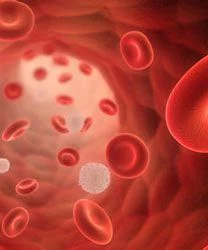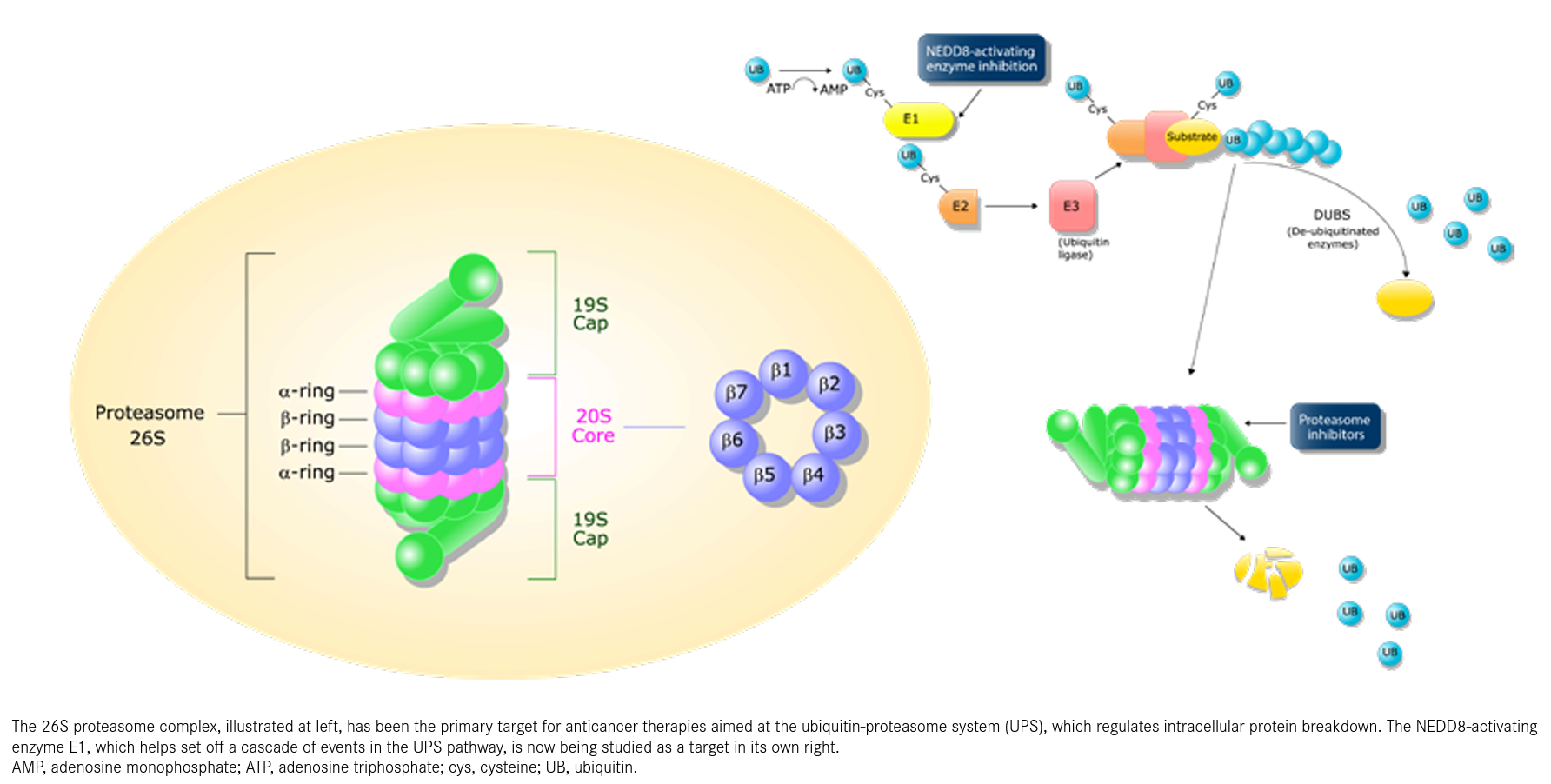Publication
Article
Oncology Live®
NEDD8 Emerges as a Novel Target in Hematologic Malignancies
Author(s):
Investigators are developing a new way to target a key oncogenic mechanism that may prove to be an effective anticancer strategy, particularly against hematologic malignancies.

Investigators are developing a new way to target a key oncogenic mechanism that may prove to be an effective anticancer strategy, particularly against hematologic malignancies.
Pevonedistat (MLN4924) is the first drug directed at the NEDD8-activating enzyme (NAE) to reach later-stage clinical development. Emerging phase 2 data demonstrating pevonedistat’s particular promise in patients with higher-risk myelodysplastic syndromes (HR-MDS), a form of the disease for which outcomes are still poor, were presented at several conferences this year and have drawn attention to this drug’s unique mechanism of action.1,2
The neddylation pathway that pevonedistat targets is a close relative of the ubiquitin-proteasome system (UPS), which is responsible for the degradation of most intracellular proteins and is vital for the maintenance of cellular homeostasis.3 Cancer cells are highly dependent on a functional UPS.4
Starting in 2003 with the approval of bortezomib (Velcade) for patients with multiple myeloma, the major strategy for targeting the UPS has been through inhibiting the proteasomes that play a central role in the pathway.5,6
Although 2 other proteasome inhibitors (PIs), carfilzomib (Kyprolis) and ixazomib (Ninlaro), are now part of the therapeutic repertoire for multiple myeloma, the approved indications for these drugs have not expanded beyond this cancer type, and the utility of the PI class overall is hindered by toxicity.3,4,7,8
Pevonedistat’s target, NAE, catalyzes the first step in the UPS pathway through an enzymatic cascade that “tags” protein substrates with the ubiquitin-like molecule NEDD8 and feeds into the UPS to regulate the degradation of a subset of cellular proteins, including tumor suppressors (Figure).6,9-11
This approach is showing early signs of success. Pevonedistat, given in combination with the hypomethylating agent azacitidine, has advanced to phase 3 clinical trials in MDS (PANTHER; NCT03268954) and acute myeloid leukemia (AML; PEVOLAM; NCT04090736). In July 2020, the FDA granted pevonedistat a breakthrough therapy designation for HR-MDS. Meanwhile, pevonedistat may also have potential in other types of hematologic malignancies and solid tumors.12-15
Figure. Structure of the Proteasome and the Ubiquitin-Proteasome System6,9-11

The Ubiquitin-Proteasome System
The UPS, a major system of intracellular protein breakdown, is responsible for the degradation of up to 80% of cellular proteins through coordinated activity of the 26S proteasome and a small protein, ubiquitin.3
The 26S proteasome is a multisubunit protease complex that breaks down proteins into smaller peptides. Proteins to be degraded are tagged with multiple ubiquitin molecules via an enzymatic cascade involving an E1 ubiquitin-activating enzyme, an E2 ubiquitin-conjugating enzyme, and an E3 ubiquitin ligase.3,4,7,8
Evidence that cancer cells have amplified dependence on the UPS, likely because of their increased metabolic demands and need to protect against apoptosis, has provoked interest in drugs targeting the UPS.4,7
The major focus has been on PIs. The 3 currently approved PIs all target the 20S core particle of the proteasome and broadly inhibit proteasome activity. Targeting the proteasome is challenging because of its essential role in cellular homeostasis, which is reflected in the toxicity associated with these drugs.3,4,7,8
PIs have proved particularly effective in patients with multiple myeloma, a cancer of the immunoglobulin-producing plasma cells. Myeloma cells produce large amounts of misfolded immunoglobulin, which is toxic to the cell unless degraded by the UPS.8 However, the success of PIs has not been replicated in other hematologic malignancies or solid tumors, with the exception of bortezomib’s approval in mantle cell lymphoma.3-5,7,8
Alternatives to UPS Targets
To develop drugs with less toxicity and greater efficacy across a broader spectrum of tumor types, investigators have begun to look for more cancer-specific ways to block UPS activity.3
NEDD8 is a ubiquitin-like molecule that is conjugated to a target protein substrate via neddylation, an enzymatic cascade that closely resembles ubiquitination. The neddylation pathway begins with NAE, the sole NEDD8 E1, which activates NEDD8 in an ATP-dependent manner.9-11,16
An NAE-NEDD8 complex is then transferred to 1 of the 2 E2 NEDD8-conjugating enzymes, UBE2F and UBE2M. The final step involves an E3 NEDD8 ligase, the best characterized of which are RBX1 and RBX2, which facilitate covalent attachment of NEDD8 to a lysine residue within the target protein.9-11,16
Unlike ubiquitination, neddylation does not directly target proteins for proteasomal degradation.6 Instead, it controls the activity, cellular localization, stability, or conformation of its substrates. Nonetheless, the neddylation pathway indirectly contributes to the proteasomal degradation of a critical subset of cellular proteins through its effects on cullin-RING ligases (CRLs).9-11,16
CRLs, the largest family of E3 ubiquitin ligases, are multiprotein complexes that control the degradation of about 20% of all cellular proteins via the UPS. Cullins, which function as scaffold proteins within the CRL complex, are the best-known neddylation substrates. Neddylation is required for activation of CRLs, and the proteins degraded by activated CRLs influence many vital biological processes.9-11,16
Although generally much less well characterized, some non-cullin proteins are also targets of neddylation. A notable example is the tumor suppressor p53, whose neddylation is catalyzed by the E3 ligase MDM2.9-11,16
In its dual role as both an E3 ubiquitin ligase and an E3 NEDD8 ligase, MDM2 can facilitate both the ubiquitination and neddylation of p53, respectively. The former leads to p53 degradation, whereas the latter inhibits its transcriptional activity.9-11,16
Studies have demonstrated that NEDD8 and many components of the neddylation pathway are overexpressed across different types of human cancer, including glioblastoma and lung, liver, esophageal, nasopharyngeal, and colorectal cancers. Furthermore, this overexpression has been shown to correlate with disease progression and poorer prognosis. Currently, immunohistochemical staining to measure levels of neddylation enzymes and global NEDD8-conjugated proteins can be used to determine the neddylation status of a tumor. In the future, neddylation status may prove useful as a biomarker predicting patient response to therapy; however, its use is currently restricted to the research setting.9,11
Pevondistat: A First-in-Class NAE Inhibitor
Components of the broader UPS beyond the 20S core particle represent a host of potentially druggable targets. Although many inhibitors of these targets have been tested in preclinical research, few have advanced to clinical trials.3 Agents targeting NAE, the E1 neddylation enzyme, represent a rare exception.
Pevonedistat potently and specifically inhibits NAE activity, and in a variety of cancer cell lines derived from solid tumors and hematologic malignancies, it was shown to block cullin neddylation, which inhibited activation of CRLs. This protected CRL substrates from UPS-mediated degradation, causing their accumulation, ultimately leading to a number of cellular outcomes, including induction of cell death and cell cycle arrest.9,17-20
In xenograft tumor models, including those derived from melanoma and colon, lung, liver, pancreatic, and ovarian cancers, pevonedistat displayed potent antitumor activity and was well tolerated. Furthermore, it was shown to have synergistic activity with a range of anticancer therapies.
A report of synergy between pevonedistat and azacitidine in a preclinical model of AML21 formed the rationale for combining the 2 agents in a phase 1 clinical trial in patients with AML (NCT01814826). Sixty-four patients aged 60 or older with treatment-naïve AML unfit for standard induction therapy were treated with pevonedistat at 20 mg/m2 or 30 mg/m2 as an intravenous infusion on days 1, 3, and 5 and azacitidine at 75 mg/m2 on days 1 to 5, 8, and 9 of 28-day cycles.
The overall response rate (ORR) in the intention-to-treat (ITT) cohort was 50%, including 20 complete remissions (CRs), 5 CRs with incomplete hematologic recovery (CRi), and 7 partial remissions. The median duration of remission was 8.3 months. The most common treatment-emergent adverse events (AEs) were constipation, nausea, fatigue, and anemia. Dose-limiting toxicities (DLTs) included elevated transaminase and bilirubin levels, and 20 mg/m2 was chosen as the recommended phase 2 dose for pevonedistat.22
Data from the phase 2 Pevonedistat-2001 trial (NCT02610777) were recently presented at the 2020 American Society of Clinical Oncology Virtual Scientific Program and the Virtual European Hematology Association Annual Congress.1,2 This open-label, randomized trial enrolled patients with HR-MDS/chronic myelomonocytic leukemia, defined as Revised International Prognostic Scoring System risk greater than 3, or low-blast AML.
Patients (N = 120) who were ineligible for stem cell transplant and had not previously received hypomethylating drugs were randomized to receive 28-day cycles of azacitidine (75 mg/m2) on days 1 to 5, 8, and 9 alone or in combination with pevonedistat (20 mg/m2) on days 1, 3, and 5.
Although not statistically significant, a trend toward improvement in overall survival (OS) was observed in the pevonedistat arm in both the ITT population (21.8 months vs 19.0 months; HR, 0.80; P = .334) and in subgroups of patients with HR-MDS (23.9 months vs 19.1 months; HR, 0.70; P = .240) and low-blast AML (23.6 months vs 16.0 months; HR, 0.49; P = .081). Notably, the study was not powered to detect a difference in OS because it was originally a secondary end point.
In addition, investigators noted a significant improvement in event-free survival (EFS; time from randomization to death or transformation to AML) in patients with HR-MDS in the pevonedistat arm (20.2 months vs 14.8 months; HR, 0.54; P = .045); EFS also trended longer in the ITT population (21.0 months vs 16.6 months; HR, 0.65; P = .060).
In the overall response-evaluable population, the ORR was 71% in the combination arm compared with 60% with azacitidine alone, and the CR plus CRi rate was 46% and 38%, respectively. Among patients with HR-MDS, 52% of those treated with pevonedistat achieved CR compared with just 27% of those in the monotherapy arm (P = .050).
The AE profiles of the combination and azacitidine monotherapy arms were comparable; grade 3 or higher AEs occurred in 90% and 87%, respectively, with the most common being neutropenia (31% vs 27%), febrile neutropenia (26% vs 29%), anemia (19% vs 27%), and thrombocytopenia (19% vs 23%). Patient-reported health-related quality of life was similar in the 2 arms, and fewer on-study deaths occurred with the combination (9% vs 16%).1,2
DLTs associated with pevonedistat are often related to hepatotoxicity, including elevated levels of bilirubin and transaminases. Rare deaths have occurred as a result of multiorgan failure and sepsis.13-15,22,23
Other Tumor Types
Several other phase 1 clinical trials have evaluated pevonedistat at escalating doses with various dosing schedules. Among 55 response-evaluable patients with AML treated with pevonedistat monotherapy, the ORR was 13% (NCT00911066).23 Results of a trial of 42 patients with relapsed/ refractory multiple myeloma or lymphoma (NCT00722488) included 3 partial responses (PRs); an additional 30 patients achieved stable disease (SD).13
Trials examining pevonedistat in nonhematologic malignancies have demonstrated some activity in patients with metastatic melanoma. Among 37 response-evaluable patients, 1 had a PR and 15 achieved SD. In 4 of those patients, SD lasted for at least 6.5 months (NCT01011530).14
Recently, pevonedistat in combination with platinum-based chemotherapy showed potential in patients with advanced solid tumors (NCT01862328). Patients were treated in 21-day cycles with escalating doses of pevonedistat starting at 15 mg/m2 on days 1, 3, and 5. Pevonedistat was combined with docetaxel 75 mg/m2 (arm 1) or carboplatin target area under the concentration-time curve of 5 mg/ mL/min plus paclitaxel 175 mg/m2 (arm 2), both on day 1. Patients were also enrolled in arm 3 evaluating pevonedistat in combination with gemcitabine, but this regimen was abandoned because of toxicity.
Among 19 evaluable patients in arm 1, the ORR was 16% (all PRs); responders included patients with cholangiocarcinoma and head and neck cancer. There was an ORR of 35% in arm 2, with 8 of 23 evaluable patients achieving PR or complete response, including patients with bladder and endometrial cancers. The median duration of response was 5.9 months in both arms.12
This study also explored the expression of the ERCC1 protein as a potential biomarker of response. A component of the nucleotide excision repair (NER) DNA repair pathway, ERCC1 is thought to be involved in resistance to platinum-based chemotherapy.12 In a lung cancer model, pevonedistat was shown to synergize with platinum-containing chemotherapy by interfering with the NER pathway. By preventing cells from using this pathway to repair platinum-induced genetic lesions, pevonedistat promotes the buildup of DNA damage that drives tumor cells to apoptosis. Thus, pevonedistat might resensitize tumors to platinum-based chemotherapy by counteracting the ERCC1/NER-mediated mechanism of resistance.12,23
ERCC1 expression was assessed using a semiquantitative algorithm that incorporates immunohistochemical staining intensity and the percentage of stained cells to calculate a “histoscore,” or H-score.24 Among 21 ERCC1-evaluable patients, those with high ERCC1 levels (H-score greater than the median of 170) tended to remain on study longer and experience greater clinical benefit than patients with low ERCC1 levels (H-score ≤ 170).12
References
- Ades L, Watts JM, Radinoff A, et al. Phase II study of pevonedistat (P) + azacitidine (A) versus A in patients (pts) with higher-risk myelodysplastic syndromes (MDS)/chronic myelomonocytic leukemia (CMML), or low-blast acute myelogenous leukemia (LB AML) (NCT02610777). J Clin Oncol. 2020;38(suppl 25):7506. doi:10.1200/JCO.2020.38.15_suppl.7506
- Ades L, Watts J, Radinoff A, et al. Phase 2 study of pevonedistat + azacitidine versus azacitidine in patients with higher-risk myelodysplastic syndromes/chronic myelomonocytic leukemia or low-blast acute myelogenous leukemia. Paper presented at: 25th Annual Congress of the European Hematology Association Virtual Meeting. June 11-21, 2020. Abstract S182.
- Zhang X, Linder S, Bazzaro M. Drug development targeting the ubiquitin–proteasome system (UPS) for the treatment of human cancers. Cancers (Basel). 2020;12(4):902. doi:10.3390/cancers12040902
- Morozov AV, Karpov VL. Proteasomes and several aspects of their heterogeneity relevant to cancer. Front Oncol. 2019;9:761. doi:10.3389/fonc.2019.00761
- Velcade. Prescribing information, Millennium Pharmaceuticals, Inc; 2019. Accessed September 21, 2020. https://bit.ly/2FDZUgx
- Deng L, Meng T, Chen L, Wei W, Wang P. The role of ubiquitination in tumorigenesis and targeted drug discovery. Signal Transduct Target Ther. 2020;5(1):11. doi:10.1038/s41392-020-0107-0
- Soave CL, Guerin T, Liu J, Dou QP. Targeting the ubiquitin-proteasome system for cancer treatment: discovering novel inhibitors from nature and drug repurposing. Cancer Metastasis Rev. 2017;36(4):717-736. doi:10.1007/s10555-017-9705-x
- Saavedra-García P, Martini F, Auner HW. Proteasome inhibition in multiple myeloma: lessons for other cancers. Am J Physiol Cell Physiol. 2020;318(3):C451-C462. doi:10.1152/ajpcell.00286.2019
- Zhou L, Zhang W, Sun Y, Jia L. Protein neddylation and its alterations in human cancers for targeted therapy. Cell Signal. 2018;44:92-102. doi:10.1016/j.cellsig.2018.01.009
- Zhou L, Jiang Y, Luo Q, Li L, Jia L. Neddylation: a novel modulator of the tumor microenvironment. Mol Cancer. 2019;18(1):77. doi:10.1186/s12943-019-0979-1
- Yu Q, Jiang Y, Sun Y. Anticancer drug discovery by targeting cullin neddylation. Acta Pharm Sin B. 2020;10(5):746-765. doi:10.1016/j.apsb.2019.09.005
- Lockhart AC, Bauer TM, Aggarwal C, et al. Phase Ib study of pevonedistat, a NEDD8-activating enzyme inhibitor, in combination with docetaxel, carboplatin and paclitaxel, or gemcitabine, in patients with advanced solid tumors. Invest New Drugs. 2019;37(1):87-97. doi:10.1007/s10637-018-0610-0
- Shah JJ, Jakubowiak AJ, O’Connor OA, et al. Phase I study of the novel investigational NEDD8-activating enzyme inhibitor pevonedistat (MLN4924) in patients with relapsed/refractory multiple myeloma or lymphoma. Clin Cancer Res. 2016;22(1):34-43. doi:10.1158/1078-0432.CCR-15-1237
- Bhatia S, Pavlick AC, Boasberg P, et al. A phase I study of the investigational NEDD8-activating enzyme inhibitor pevonedistat (TAK-924/MLN4924) in patients with metastatic melanoma. Invest New Drugs. 2016;34(4):439-449. doi:10.1007/s10637-016-0348-5
- Sarantopoulos J, Shapiro GI, Cohen RB, et al. Phase I study of the investigational NEDD8-activating enzyme inhibitor pevonedistat (TAK-924/MLN4924) in patients with advanced solid tumors. Clin Cancer Res. 2016;22(4):847-857. doi:10.1158/1078-0432.CCR-15-1338
- Ying J, Zhang M, Qiu X, Lu Y. Targeting the neddylation pathway in cells as a potential therapeutic approach for diseases. Cancer Chemother Pharmacol. 2018;81(5):797-808. doi:10.1007/s00280-018-3541-8
- Soucy TA, Smith PG, Milhollen MA, et al. An inhibitor of NEDD8-activating enzyme as a new approach to treat cancer. Nature. 2009;458(7239):732-736. doi:10.1038/nature07884
- Milhollen MA, Traore T, Adams-Duffy J, et al. MLN4924, a NEDD8-activating enzyme inhibitor, is active in diffuse large B-cell lymphoma models: rationale for treatment of NF-κB–dependent lymphoma. Blood. 2010;116(9):1515-1523. doi:10.1182/blood-2010-03-272567
- Swords RT, Kelly KR, Smith PG, et al. Inhibition of NEDD8-activating enzyme: a novel approach for the treatment of acute myeloid leukemia. Blood. 2010;115(18):3796-3800. doi:10.1182/blood-2009-11-254862
- Luo Z, Yu G, Lee HW, et al. The Nedd8-activating enzyme inhibitor MLN4924 induces autophagy and apoptosis to suppress liver cancer cell growth. Cancer Res. 2012;72(13):3360-3371. doi:10.1158/0008-5472.CAN-12-0388
- Smith PG, Traore T, Grossman S, et al. Azacitidine/decitabine synergism with the NEDD8-activating enzyme inhibitor MLN4924 in pre-clinical AML models. Blood. 2011;118(21):578. doi:10.1182/blood.V118.21.578.578
- Swords RT, Coutre S, Maris MB, et al. Pevonedistat, a first-in-class NEDD8-activating enzyme inhibitor, combined with azacitidine in patients with AML. Blood. 2018;131(13):1415-1424. doi:10.1182/blood-2017-09-805895
- Swords RT, Watts J, Erba HP, et al. Expanded safety analysis of pevonedistat, a first-in-class NEDD8-activating enzyme inhibitor, in patients with acute myeloid leukemia and myelodysplastic syndromes. Blood Cancer J. 2017;7(2):e520. doi:10.1038/bcj.2017.1
- Bouck DC, Garcia K, Blank JL, et al. Nedd8-activating enzyme inhibitor pevonedistat synergizes with cisplatin and carboplatin through interference with nucleotide excision repair and interstrand cross-link repair mechanisms in non-small cell lung cancer. Mol Cancer Ther. 2015;14(12; suppl 2):C55. doi:10.1158/1535-7163.TARG-15-C55
























%20(2)%201-Recovered-Recovered-Recovered-Recovered-Recovered-Recovered-Recovered-Recovered-Recovered-Recovered-Recovered-Recovered-Recovered-Recovered-Recovered-Recovered-Recovered.jpg?fit=crop&auto=format)
%20(2)%201-Recovered-Recovered-Recovered-Recovered-Recovered-Recovered-Recovered-Recovered-Recovered-Recovered-Recovered-Recovered-Recovered-Recovered-Recovered-Recovered-Recovered.jpg?fit=crop&auto=format)
